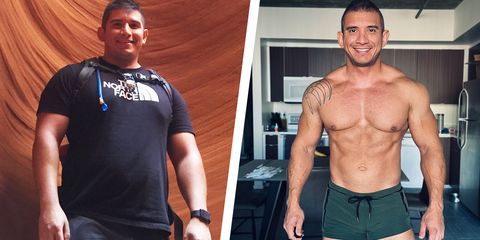I got bullied a lot in high school because I was really skinny and easy to pick on. I started weightlifting around 15 years old because I wanted to get bigger, and it helped to not get bullied so much. But I kept eating to gain size, and eventually, I was getting fat—I just couldn’t see it. That was in my early 20s.
I work in tech, so I sit all day working on websites or designing—whatever. Posture hits people like us the most: back pain, sciatica, just to name a few. I had those, and they got worse as I got heavier, but I always attributed the pain to other things, like not exercising correctly, and perhaps injuring myself.
At my heaviest, I weighed around 250 pounds. I would get tired easily going up and down stairs, my sex drive was low, and I was depressed without really even knowing it. I was also quite anxious. I was 33.
I would also get tired doing any type of cardio, and the depression was not necessarily because I was overweight. More or less, I was overweight because of anxiety and depression. Those two were huge ruling factors in my overall mental and physical health at the time.
The turning point came when I visit my doctor about terrible sciatica pain. I didn’t even think I was obese; I thought I’d just picked up an injury. Toward the end of my visit, he asked—in the nicest way possible—if I ever considered losing fat, because my belly was probably causing my back pain. I was carrying around 28 percent body fat, and having a belly was more than likely a major factor playing into my sciatica and back pain.

To turn things around, I really had to start with my mental and emotional state. Anxiety and depression had me eating a lot; talking through with a therapist some of my issues really helped. I worked with a therapist for a total of 4 years before and during my weight loss process. After a tough breakup I went to the Grand Canyon; when I saw myself in a picture from the trip, I realized I needed to take care of myself. I was 252 pounds. That photo put a lot of things into perspective, especially my physical health.
I started HIIT classes three to four times a week, then hitting the gym on my own three or four days a week. I saw really quick results—dropping to about 195 pounds in four months in 2018—but it was pretty brutal exercising that much on a 1900-calorie-a-day diet. In 2019, I put about 20 pounds back on, and after being dumped in March of 2020, I decided to push myself further and get where I’m at now—about 208 pounds, but much leaner.
I’ve had a couple rebounds where I’ve gained weight, and right now I’ve gotten even leaner, so I’m looking to put on more mass.

I started posting my quarantine workouts on Instagram and Facebook this year while I was slimming down. I used to be embarrassed to post pictures on social media showing my belly; now I have no problem doing that. A lot of my family and friends were shocked, giving me a lot of positive feedback.
Most importantly, I’m pain-free now. I’m really happy and more confident. Focusing on improving myself during quarantine really just took me to a new level of happiness that I have never experienced, not even in my 20s.
People ask me for advice now, I always say the biggest motivating factor is you. There’s no waving a magic wand to summon your motivation, or transform how you look. It has to come from inside—don’t compare yourself to other people, but think about what makes you unique. Treat yourself with respect, and honor the fact that you are not perfect; no one is. —As told to Jesse Hicks
Source: Read Full Article
